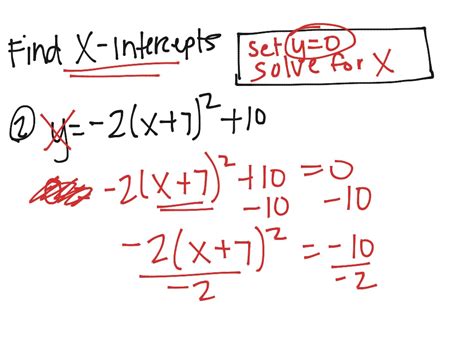Understanding the x-intercept is crucial for graphing and analyzing functions. The x-intercept is the point where the graph of a function crosses the x-axis, meaning the y-coordinate is zero. When working with vertex form, also known as the vertex representation of a parabola, (y = a(x - h)^2 + k), finding the x-intercept involves solving for x when y is equal to zero. Here are three methods to find the x-intercept from vertex form:
Method 1: Substitution and Solving

Given the vertex form (y = a(x - h)^2 + k), to find the x-intercept, substitute (y = 0) into the equation. This gives us (0 = a(x - h)^2 + k). Rearranging the equation to solve for x involves several steps:
- Subtract (k) from both sides: (-k = a(x - h)^2)
- Divide both sides by (a): (-k/a = (x - h)^2)
- Take the square root of both sides: (\sqrt{-k/a} = x - h) or (-\sqrt{-k/a} = x - h)
- Add (h) to both sides to solve for (x): (x = h + \sqrt{-k/a}) or (x = h - \sqrt{-k/a})
Example
Given the equation (y = 2(x - 3)^2 - 5), find the x-intercept.
- Substitute (y = 0): (0 = 2(x - 3)^2 - 5)
- Add 5 to both sides: (5 = 2(x - 3)^2)
- Divide by 2: (2.5 = (x - 3)^2)
- Take the square root: (\sqrt{2.5} = x - 3) or (-\sqrt{2.5} = x - 3)
- Add 3 to both sides: (x = 3 + \sqrt{2.5}) or (x = 3 - \sqrt{2.5})
Method 2: Factoring

This method is more straightforward if the equation can be easily factored after substituting (y = 0). The vertex form, after setting (y = 0), becomes (0 = a(x - h)^2 + k). Rearrange and attempt to factor the quadratic expression if possible:
[0 = a(x - h)^2 + k]
However, vertex form does not lend itself easily to factoring directly. This method might be more of a check for the solutions obtained through other means or used in simpler forms of the equation.
Method 3: Using the Quadratic Formula

The quadratic formula, (x = \frac{-b \pm \sqrt{b^2 - 4ac}}{2a}), can be used by transforming the vertex form into standard quadratic form, (y = ax^2 + bx + c), or directly if one recognizes the standard form within the vertex form equation.
Given (y = a(x - h)^2 + k), expand it:
[y = a(x^2 - 2hx + h^2) + k] [y = ax^2 - 2ahx + ah^2 + k]
Comparing with (y = ax^2 + bx + c), we see (b = -2ah) and (c = ah^2 + k). Setting (y = 0) and substituting into the quadratic formula:
[x = \frac{2ah \pm \sqrt{(-2ah)^2 - 4a(ah^2 + k)}}{2a}] [x = \frac{2ah \pm \sqrt{4a^2h^2 - 4a^2h^2 - 4ak}}{2a}] [x = \frac{2ah \pm \sqrt{-4ak}}{2a}] [x = h \pm \frac{\sqrt{-4ak}}{2a}]
This simplifies to the same solutions as obtained through direct substitution and solving.
Engagement
Finding the x-intercept from vertex form involves understanding the properties of quadratic equations and the different forms they can take. Whether through substitution, factoring (when possible), or using the quadratic formula, mastering these methods enhances problem-solving skills and the ability to analyze functions. Share your thoughts on the most intuitive method for you or ask about applications of x-intercepts in real-world problems.
